Preserving Basil
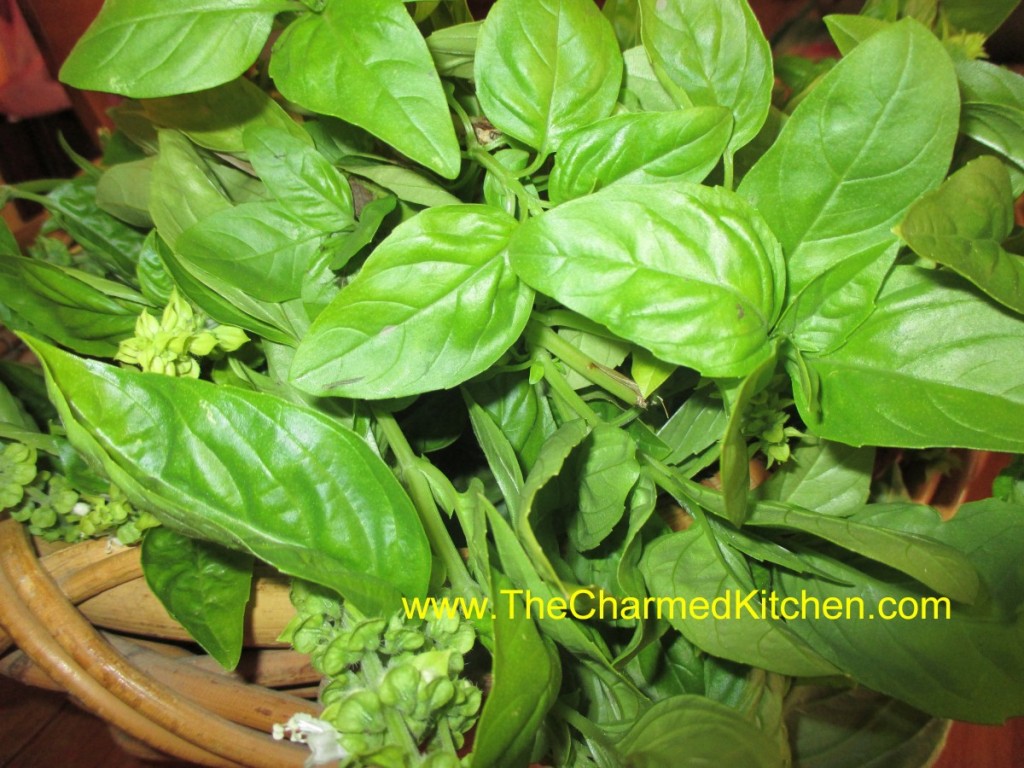
This time of year, I am looking to preserve as many herbs as I can, to enjoy year round. Basil is one of my favorites. I grow, and use, a lot of it. I am doing a major harvest of basil today. Some will be frozen in olive oil, some dried, and some added to vinegar.
None of the preservation methods is difficult. Basil can be tricky to dry, though. Unlike a lot of herbs, basil does not air dry well. I have a dehydrator, but if you don’t have one, you can still dry your basil successfully. Believe it or not, you can dry basil, and other herbs, in a microwave. Directions follow.
So I am off to harvest my basil. One thing is sure- my house will smell really good today.
Freezing in Oil
To use basil in pesto sauce, dried just won’t do. You can easily freeze your basil in olive oil and have it ready whenever you want it. Just place clean basil leaves in a blender or food processor and add olive oil. It is important that you use olive oil because it freezes solid. While the machine is running pour in oil until basil is blended. I use very little oil for two reasons. It takes up less room in the freezer and I don’t need so much oil. I can add more oil when I use it, but this way if I am doing a big batch i don’t go through all my oil. Once the mixture is blended pour or spoon it into ice cube trays and freeze. Once frozen solid pop out the basil cubes and put in freezer bags and return to the freezer.You can also freeze chopped basil without the oil. I like it better in the oil, but I freeze other herbs by just chopping them up and freezing them.
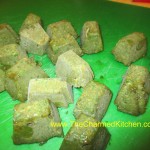
Frozen Basil Cubes
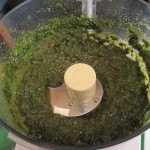
Process basil and olive oil until smooth
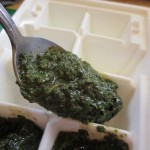
Spoon mixture into ice cube trays and freeze
Microwave Drying
If you don’t have a dehydrator you can dry herbs in your microwave. It only takes a couple of minutes per batch. Just place a handful of fresh, clean basil leaves in a linen-type kitchen towel. Fold the towel over the herbs and place in the microwave. Be sure to put a raw potato in with the herbs in the oven. If you only put the herbs in, it is like running the oven empty and can damage the microwave. Just put the potato off to the side. If you do several batches you will have a baked potato. ? If you have a turntable, just cook on high for 2 minutes. Check and see if they are dry- you might need a little more time. I need about 2 1/2 minutes in my microwave. Better to put them in for 15 more seconds at a time than to over dry them. If you don’t have a turntable microwave on high for a minute. After the first minute turn the herbs 1/4 turn and cook 15 seconds, turn again and cook another 15 seconds. Repeat four times in all. You can dry other herbs in the microwave. Small leaved herbs like thyme are done even faster. Remove the herbs from the oven and allow them to cool. check if they are dry enough and return, wrapped to cook longer if needed. Store in containers in a cool place.
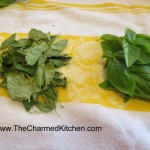
Microwave dried basil on the left and fresh basil on the right

Place fresh basil on a towel and fold towel over the herbs
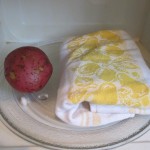
Place in microwave with a potato
All microwaves are different. Some will take longer and some even less time. Watch your herbs carefully. While I have never seen it happen I was told once that theoretically, they could catch on fire if left in too long. Urban legend perhaps, but just be careful.
Herb Vinegar
When I grow basil, I try to keep the blossoms pinched off. Better for leaf production. But by this time of year some are blooming. Rather than dumping the blossoms you can use them to flavor vinegar. Just snip off the blossoms and place them in a sterilized bottle or jar. Use several sprigs of basil flowers for every 2 cups of vinegar. Make sure the vinegar is at least 5% acidity. I like to use different vinegars for different herbs. I often use cider vinegar, red wine vinegar (for purple basil) and white wine vinegar. Leaves can be used, too. Vinegar should be heated up to 190 degrees- or just below the boiling point. Close up the jar and store in a cool place (50-70 degrees) for a couple of weeks. Before using strain out the herbs and filter- I use coffee filters or you could use cheese cloth. Store in a pretty bottle, if you have one. They can be kept for up to a year when stored in the fridge.

Basil blossoms in vinegar
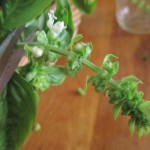
Snip off basil blossoms
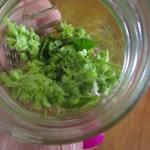
Place blossoms in a jar or bottle
Pesto Sauce
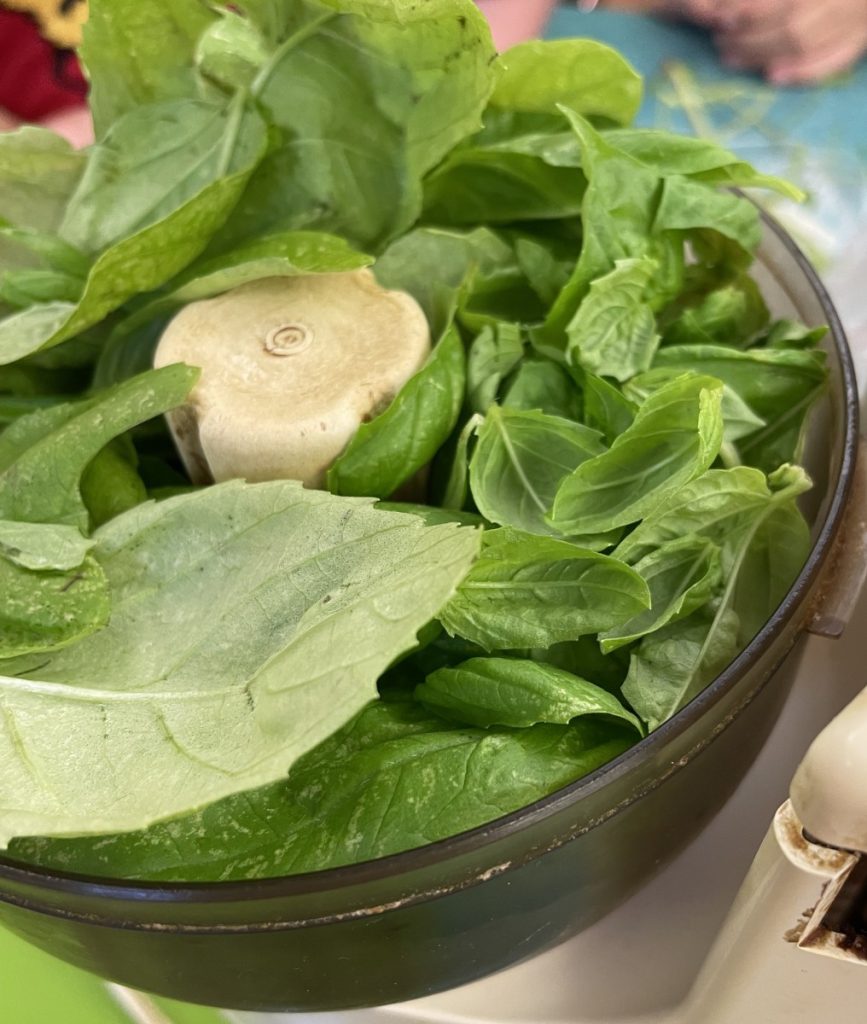
In cooking camp yesterday the kids made fresh pesto sauce. I wasn’t 100% sure if they would like, but it turns out it was one of their favorite dishes.
Pesto is most often made with basil, but there are a lot of variations out there. Pesto can be made from parsley, sun dried tomatoes, spinach or mint.
I must admit to being a big fan of the original.
I make pesto often when I have fresh basil. I also freeze basil with olive oil, so I can make it all year long. Pesto can be tossed with pasta, rice, potatoes or other veggies. I also like pesto on chicken.
Basil Pesto Sauce
1 c. tightly packed basil leaves
1/4 c. olive oil, or more as needed
3-4 cloves garlic
Salt to taste
1/2 c. pine nuts, sunflower seeds, pecans or walnuts- I like to toast the nuts first
1 c. fresh grated Parmesan cheese
Combine all ingredients, except the cheese, in a blender and mix until smooth. Stir in the cheese and toss over hot, cooked pasta or use as a sauce on meat and poultry. Sauce will keep a few days in the fridge and makes about 1 1/2 cups, enough for 1 lb. of cooked pasta.

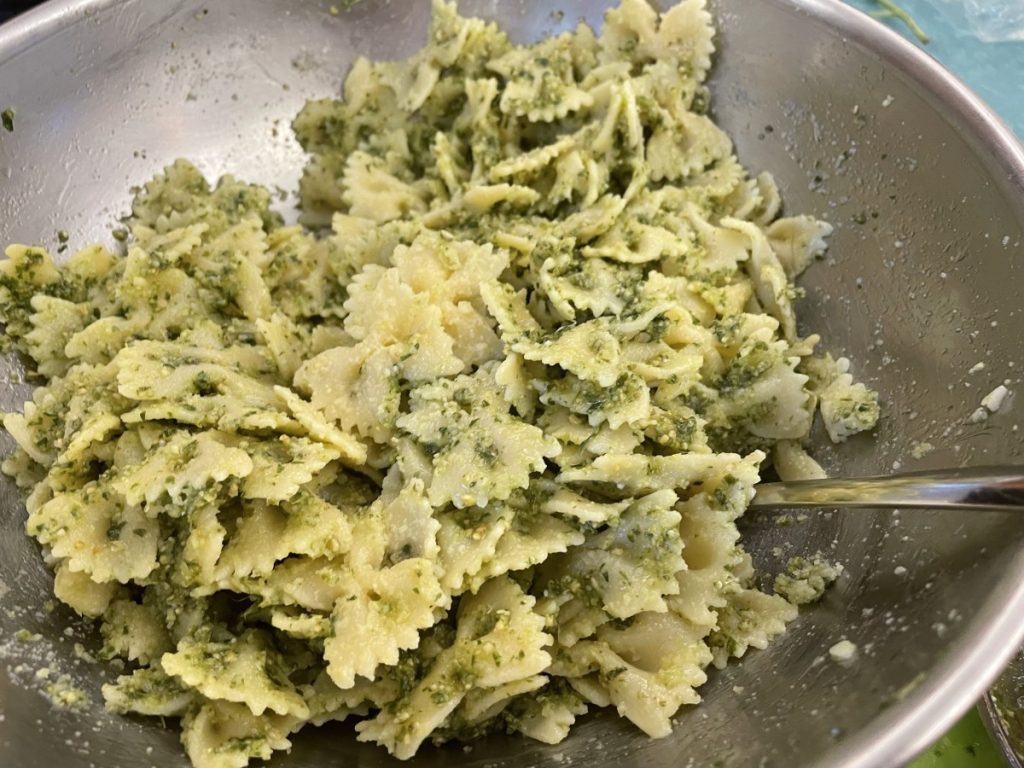
Pesto Sauce

In cooking camp yesterday the kids made fresh pesto sauce. I wasn’t 100% sure if they would like, but it turns out it was one of their favorite dishes.
Pesto is most often made with basil, but there are a lot of variations out there. Pesto can be made from parsley, sun dried tomatoes, spinach or mint.
I must admit to being a big fan of the original.
I make pesto often when I have fresh basil. I also freeze basil with olive oil, so I can make it all year long. Pesto can be tossed with pasta, rice, potatoes or other veggies. I also like pesto on chicken.
Basil Pesto Sauce
1 c. tightly packed basil leaves
1/4 c. olive oil, or more as needed
3-4 cloves garlic
Salt to taste
1/2 c. pine nuts, sunflower seeds, pecans or walnuts- I like to toast the nuts first
1 c. fresh grated Parmesan cheese
Combine all ingredients, except the cheese, in a blender and mix until smooth. Stir in the cheese and toss over hot, cooked pasta or use as a sauce on meat and poultry. Sauce will keep a few days in the fridge and makes about 1 1/2 cups, enough for 1 lb. of cooked pasta.


Preserving Basil On New Day Cleveland
Here is my latest television appearance. I had so much fun on the show. David Moss is a lot of fun to talk cooking with. Everyone that works on the show make me feel welcome. Always a good time.
http://fox8.com/2017/08/03/how-to-make-your-garden-herbs-last-year-round/
Tomato Basil Breadsticks
I have had a lot of breadsticks over the years, but honestly, I didn’t like most of them. They were always too dry or flavorless. I love these. They are full of flavor and while you can bake them until they are really crisp, you can also bake them until they are still a little tender and chewy, rather than crisp.
Tomato Basil Breadsticks
2 T. olive oil
1/3 c. chopped onion
2 cloves minced garlic
1/2 c. tomato puree
1/3 c. water
3-3 1/2 c. flour
2 t. salt
1 t. sugar
2 t. dried basil
1 packet fast-acting yeast
1 egg combined with 1T. water
coarse salt for sprinkling
Sauté onion and garlic in oil until onion is tender. Stir in tomato puree and water and combine well. In bowl, with electric mixer combine 3 c. of the flour with salt, sugar, basil and yeast and stir in tomato mixture. Beat until smooth, adding the rest of the flour, Mixture should be sticky. Place dough in a well-oiled bowl, cover with plastic wrap and chill overnight. Pinch off walnut-sized pieces of the dough and roll into 8-inch long strips. Place on baking sheets covered with parchment paper. Brush lightly with the egg wash and sprinkle with the salt. Bake in upper third of 325-degree oven (it will take 2 batches) for 45 minutes (soft breadsticks) or 1 1/2 hours (crisp breadsticks). Makes about 25.





